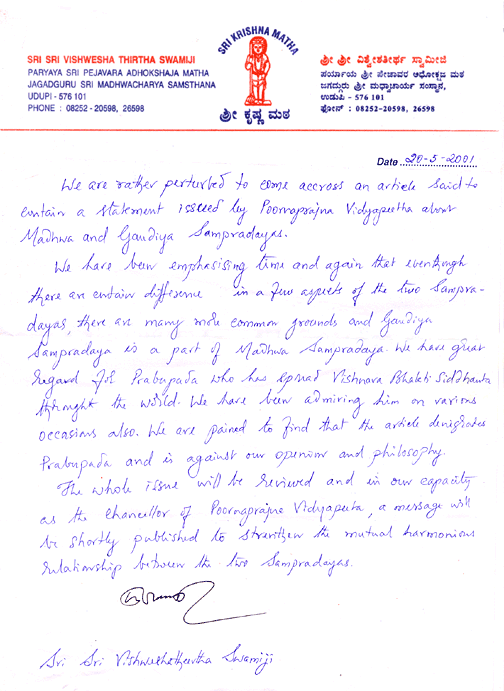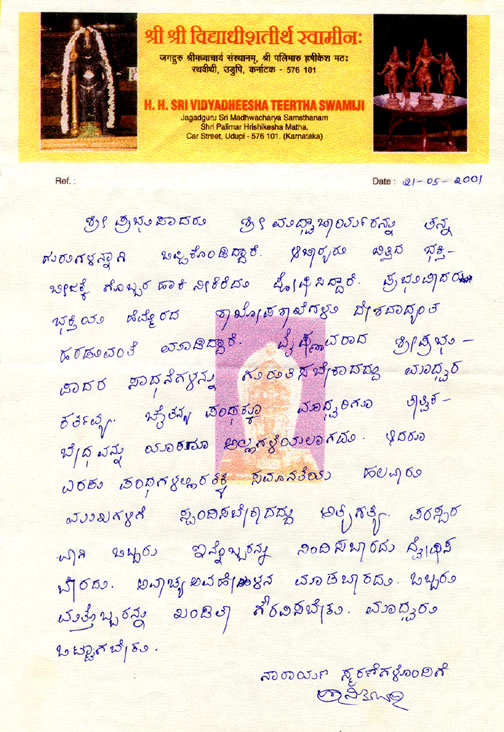also chaitanya has said that this (sannyasa) is also to be rejected.
chaitany himself has said that in the Age of Kali there is no prescription for sannyasa citing as evidence the Brahma-vaivarta Purana: (how laughable first to quote BVP and second to reject it )
asvamedham gavlambham sannyasam palapaitrikam |
devarena sutotpattim kalau pañca vivarjayet || (1.17.7)
Dude, I think you are just copying and pasting these weak arguements from this Anti-Gaudiya website.That site is so wrong, they have no evidence to back claims. If you read the commentary on that verse afterwards, Lord Chaitanya Mahaprabhu explains that this Sannayasa refers to Karma Sannayasa. Our response, (by Srila Bhaktirakshaka Sridhara Maharaj) is as follows:
"The interpretation is this: in this present age,
sannyasa in the strict sense of
karma-sannyasa is forbidden.
Karma-sannyasa means that you leave everything, and that type of
sannyasa is not possible in this present age. It is described in the
sastras that in Satya-yuga, as long as a man’s bones exist, that is how long he will live. Along with the longevity of the bones, the life will be there. In Treta-yuga, life may be maintained by the nervous system; but it is stated that in
kali-yuga ‘kalav-annagatah pranah’ – one’s longevity depends on food. Therefore
sannyasa in the strict sense is not possible in
kali-yuga.
Previously, Valmiki was engaged in tapasya for so many years that the insects captured his whole body and reduced his flesh into earth, yet he remained present within his bones. Then later, by the help of some spiritual miracle his whole body was restored. But in this present age, without food it is not possible to live. All penances have been especially adjusted for
kali-yuga,and the only continuous fast allowed in this present age is for twenty-four hours - not more than that. In other ages, at least twelve days fasting was generally done. If a person had done anything wrong, then according to the smrti-sastra, twelve days fasting was the standard punishment for any sins. But in
kali-yuga, twenty-four hours fasting is the maximum because without food a man cannot survive.
If he were to take
karma-sannyasa while being so extremely dependent on material giving and taking, then he wouldn’t be able to maintain his existence. But the life of Vaisnava
tridandi-sannyasa, which is not very extreme – take
prasadam, do service – is a sort of modified form based on
yuktahara viharas ca, and one living according to this principle can take
sannyasa.
Mahaprabhu took
sannyasa, Sankaracarya, Ramanuja – all the pioneers of the different
sampradayas took
sannyasa. That (in the verse) has been interpreted as
karma-sannyasa, but still,
sannyasa is of several kinds. There is also
vidvat-sannaysa, which is considered by the salvationist section to be the highest. Their idea is that when one has fully realized that his connection with this material realm is a negative one, he will finish his material encasement and enter into the spiritual sphere. When he is fully established in this firm consciousness that ‘my connection with the material world will be injurious to me,’ he will then relinquish his body and go away to the spiritual sky. That is
vidvat-sannyasa.
There is also
narottama-sannyasa:
yah svakat parato veha
jata-nirveda atmavan
hrdi krtva harim geyat
pravrajet sa narottamah
In the narottama system of
sannyasa, one has realized the presence of or existence of God within his heart, and thinking of Him, he leaves his present engagement and duties of the household and remains outside, anywhere and everywhere – under a tree or in a cave or wherever – careless of his physical needs. He does not immediately relinquish his body, but he takes whatever food he gets and when he does not get any food he fasts, and in this way he goes on. He leaves his household for good; that is
narotttama-sannyasa.
And there are also different stages of
sannyasa mentioned in the
sastra: kuticaka, bahudaka, hamsa and
paramahamsa progressively. But
tridandi-sannyasa is when the
sannyasi engages himself in the service of Godhead by spreading His message and doing some good to the public, and that characteristic is different. It is categorically different. The
tridandi-sannyasi is not adopting an attitude or tactic of leaving all the engagements of this world as a result of becoming disgusted with its many temptations. Rather, he is engaging himself in the higher duty of the upper world through an agent, so his body has got utility. Remaining here, maintaining connection here, he is drawing some higher thing from above and distributing that in the environment. That is another conception of
sannyasa, and it has positive value.
This is a similar engagement to that performed by the Lord’s closest associates. When an incarnation of God comes down, His favorite
parsadas, His friends and servitors, are also sent by Him to come down to do some service to help Him. There are also sub-agents who have received some engagement from the higher agent, and by moving within this world in that capacity, they can earn more spiritual wealth than those who are very eager to disconnect completely from this material plane. They want to try to utilize their connection with this mundane plane to earn some substantial wealth of the upper house. So like the Lord’s
parsadas, the
tridandi-sannyasis want to work as God’s agents.”
Although members of the anti-devotional parties and their unwitting dupes attempt to condemn the
sannyasa-asrama by using the verse from the
Brahma-vaivarta Purana, the following verse from the same Purana has conveniently escaped their attention.
dandam kamandalum rakta-vastram matranca dharayet
nityam pravasi naikatra sa sannyasiti kirttitah
“A sannyasi accepts only a danda, water-pot, and saffron-cloth and resides near a village – this is the wealth of the
sannyasa asrama.”(Brahma-vaivarta Purana 2.36.9)
In fact, throughout the vast body of Vedic literature, only one verse can be found wherein the
sannyasa order is apparently forbidden in the age of
kali. In all the other
sastras that were written for the people of this present age a man is repeatedly urged to take up
sannyasa." - BR Sridhara Maharaj
Also Lord Chaitanya Mahaprabhu never broke his thread.



